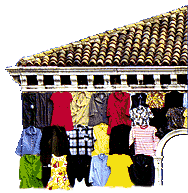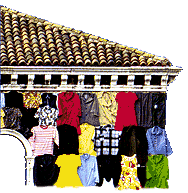
The Dress that's Stylish
Fiora Gandolfi
Any form of dressing, train and foaming wedding veil, crumpled T-shirt, torn blue-jeans, glasses concealing the glaze, mirror of the soul, scraping/cropping and piercing on the lips or other more intimate parts, visible signs of masochist impulses and whims to become slaves: all must be considered as embellishments of the self. And they are, tanga included, the enlarging, extension and magnification of the idea one has of his/her body.
No clothing item makes one smaller. It always underlines by drawing the attention to fears, foibles/tics, presumed richness or poverty. The lavender-smelling starchiness of past times, today's crumpling, yesterday's meticulous embroidery, now changed for the rip the ancestors of which are the stabbed jackets, that is torn and spurting red silken pouring, blood symbols are the emblems of bloody epochs. And also the ten-thousand-mink coats tell of presumed opulence, with a leap forward in the social scale. The coloured scarves, worn as flags, litigious or monotonous tie/knots, these are the revealing banners of expressed humours and latent passions. Whether satanic, conformist or minimalist-angelic, clothing has always been the visual metaphor of soul. The mise is able to tell the story and the destinies of its unaware proprietors.
Through the waistcoat and the buttonhole flower, the village groom wearing a ceremony dress he knows he does not deserve just for one day reveals that he has borrowed these clothes from a higher social class.
His silken foulard with trappings, stirrups and scenes of fox hunting (forbidden by the Law, in any case) referring to the presumed acquaintance with aristocratic stables betrays, on the contrary, daily meetings with cauliflower and frying pans. All around the world jewels and dresses tell about the humours, but being Identity Cards as well. The Berberi of the Atlas usually wear big buckles of different shapes which identify the fact of belonging to the different tribes. As soon as they are seen on the distant sand, they will be recognized.
Jewels have a prophylactic function red horn-shaped amulets, coral hearts, turquoise Fatima's hands, sacred icons with carved in gold protect one from illnesses and the devil eye.
The shirt with its logo and the many-coloured sacks are talismans rich in symbolic meanings, amulets at the higher stage of their own evolution. Bragged on the right side of bags, jackets, trousers the tab revealing the brand acts as a fiscal code. It reveals one's bank account, be it real or presumed. It uses ciphers instead of letters: Gucci = 1.500.000 liras. The little green crocodile on the polo speaks of numbers.
An end-of-the-century's dilemma: does the cowl make the monk or l'hâbit fait le moine? Does it really make it, as the French believe and have expressed by centuries of fashion and style, or does it not, as we Italians affirm? Or else, couldn't it be that it's the monk who makes the cowl? The personality of those who are wearing the dress, their gesturing, their intelligence which turn an idle cloth into a drape capable of emanating emotions in a cut-and-sewed stuff capable of honouring the body, temple of the soul?
In any case, the dress exerts a great moral influence on those who wear it. It does not make us look more beautiful, but it makes us feel smarter (or uglier; if it's pleasant) and also more modern, darting, dynamic. The banded athletic shoes seem to set the foot in motion more rapidly. By the same token, the pyjama's traditionally vertical stripes seem to be protecting sleep by encircling the slumbering one in an imaginary cage, sheltering his/her body in a space protected by bars.
In any case, the dress is always a symbol of belonging. Lepers were wrapped up in special tunics and used to wear small bells. The Sun King had to wear lace bands embroidered with silver and golden threads. Silks and wool cloths, sleeves and belts used to define the trades unequivocally. In oil paintings prostitutes were symbolically represented embellished by pierced pearls.
In all epochs and countries the dress had the function of sanctioning the gender of those who wore it. This custom has been dissolving at the end of the Millennium, surprising and unique revolution in the history of fashion. The transgression to the sumptuary ritual involving gender were even punished with the stake. The judges were able to condemn Jeanne D'Arc to death for an assessed crime only: that of repeatedly wearing trousers. As a matter of fact, trousers had remained men's absolute privilege. Progressive intellectual and painter Eugène Delacroix, considered trousers as a direct insult to male rights.
On the contrary, the pope is above the fray: for centuries he has been wearing the gown, just like women do. And the clergy man, bringing priests back to their status of small men, has had to struggle to impose himself upon the black tunic with its thousands minute buttons. Just a scandal. Will 21st century men dress up with white feathers to look more like angels? Will that be right? Will it be good-tasted?
The dress, revealing and changeable mask will always keep in the balance between the unstoppable swinging of the idea of stylish.
